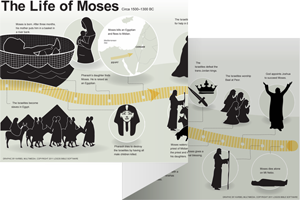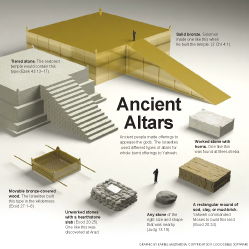The Future of Bible Study Is Here.
 Loading…
Loading…
You have not started any reading plans.
- More »
Sign in or register for a free account to set your preferred Bible and rate books.
17:1–7 In this passage, a location previously called Rephidim is renamed Massah and Meribah after the Israelites complain of a lack of water. Later, this location is known proverbially as the place Israel tested Yahweh (see Deut 6:16; 9:22; 33:8; Psa 95:8). A similar event takes place in Num 20. |
17:1 the desert of Sin See note on Exod 16:1.
Rephidim Exodus 19:2 indicates this as the final stop before the Israelites arrive at Sinai (compare Num 33:14–15). It is located near Horeb (see Exod 17:6), another term for Mount Sinai (see 3:1 and note). The exact location of the site is unknown, partly because the exact location of Mount Sinai is also unknown (see 3:1).
(compare Num 33:14–15). It is located near Horeb (see Exod 17:6), another term for Mount Sinai (see 3:1 and note). The exact location of the site is unknown, partly because the exact location of Mount Sinai is also unknown (see 3:1).
The term “Rephidim” may refer to the area near the Wadi Refayid. This would place Israel near the oasis of the Wadi Feiran—an option consistent with the traditional location for Sinai (see 3:1). However, if this identification is correct, the lack of water appears odd given the proximity of an oasis. They may have been miles from the water, though, as the narrative does not specify the distance.
Rephidim may also be located on the ridge of Er Rafid, on the east coast of Aqaba. This location is consistent with alternative locations for Sinai near Midian.
 Wilderness, Desert DOT: P
Wilderness, Desert DOT: P
 Sinai, Mount (Place) AYBD
Sinai, Mount (Place) AYBD
17:2 Why do you test See 15:22–25; 16:1–8 (compare Deut 6:16; Pss 78:18, 41; 95:8, 9).
17:3 to kill me and my sons Language similar to Exod 15:22–25.
17:5 Go on before the people Instead of reacting with anger, God will show His power. After He gives the law to the Israelites at Sinai (ch. 20), God will exhibit far less patience (see Num 11:1; 14:2, 11, 27–29).
the elders of Israel Tribal leaders. See note on Exod 3:16.
 Leadership, Elders DOT: P
Leadership, Elders DOT: P
with which you struck the Nile See 7:15–25.
water will come out from it If the rock was limestone, a sharp blow could cause it to break and release groundwater. However, since the precise location of this event is unknown, this interpretation is speculative. Ultimately, the result is attributed to God.
17:7 Massah The Hebrew word used here means “testing.”
Meribah The Hebrew word used here means “quarreling.” This name and the name Massah derive from the Hebrew verbs used here and in 16:2.
In the similar event narrated in Num 20, the place names are merivah and qadesh—massah is not mentioned. This event takes place after the Israelites depart from Sinai. See note on Num 20:2–13.
17:8–16 When the Amalekites attack them, the Israelites encounter their first opposition from other people since arriving in the wilderness. The Amalekites apparently interpreted the appearance of the Israelites as a threat to their territory and its resources. Other details of this conflict are found in Deut 25:17–19, which describes a surprise attack by the Amalekites at the back of Israel’s wandering assembly. |
17:8 Amalek The Amalekites were descendants of Esau (Edom) (Gen 36:12, 16). The territory of the Amalekites was situated in the desert south of Canaan, north of the Israelites’ location at this time (Gen 14:7; Num 13:29).
were descendants of Esau (Edom) (Gen 36:12, 16). The territory of the Amalekites was situated in the desert south of Canaan, north of the Israelites’ location at this time (Gen 14:7; Num 13:29).
 Amalek (Person) AYBD
Amalek (Person) AYBD
17:9 Joshua The first reference to Joshua in the ot. He will become Moses’ commander-in-chief and lead the Israelites’ conquest of Canaan.
 Joshua DOT: HB
Joshua DOT: HB
 Joshua (Person) AYBD
Joshua (Person) AYBD
the staff of God will be in my hand God had not instructed Moses to hold up or point the staff of God over the battle scene. However, God had previously done miraculous things when he did so (Exod 7:12–20; 8:5, 16; 9:23; 10:13; 14:16).
17:10 Hur A high-ranking leader. Hur would later be one of the leaders who assisted Aaron in governing the people while Moses was on Mount Sinai (24:14). He may be the same Hur who was the grandfather of Bezalel—one of the craftsmen who built the tabernacle and its furnishings (see 31:2; 35:30; 38:22; 1 Chr 2:20). Later tradition names Hur as the husband of Miriam, the sister of Moses and Aaron (Josephus, Antiquities 3.54).
Hur would later be one of the leaders who assisted Aaron in governing the people while Moses was on Mount Sinai (24:14). He may be the same Hur who was the grandfather of Bezalel—one of the craftsmen who built the tabernacle and its furnishings (see 31:2; 35:30; 38:22; 1 Chr 2:20). Later tradition names Hur as the husband of Miriam, the sister of Moses and Aaron (Josephus, Antiquities 3.54).
17:11 he rested his hand The significance of the gesture is never explained. All that is known is that Moses had the staff of God with him. Moses may have held the staff over his head with two hands (Exod 17:12).
Moses holding up the staff may serve as a visible reminder to the soldiers that God will fight for them—they would be emboldened by the staff. It seems unlikely that God’s power was somehow triggered by the position of Moses’ arms—especially since the account does not include God instructing Moses to do this.
17:14 Write this The first mention of writing in the Bible. Although no documents composed in early Hebrew writing before the 10th century bc have survived, the Hebrew alphabet is much older (circa 17th century bc). It developed from Egyptian hieroglyphs, as shown by inscriptions found in a turquoise mine run by Egyptians (Serabit el-Khadim, in the Sinai region).
 Writing DOT: P
Writing DOT: P
I will utterly blot out the remembrance of Amalek from under the heavens Yahweh commands Moses to write down his promise to destroy Amalekites; they would suffer the same fate as other people groups targeted in the conquest of Canaan (see Deut 2:34; Josh 2:10; 6:17–21). However, this did not happen during the conquest; the Amalekites would continue into the time of Saul and David (1 Sam 15; 30).
17:15 Moses built an altar For the practice of erecting and naming altars, see Gen 33:20; 35:7; Judg 6:24. None of these occasions included a sacrifice (compare Josh 22:26–27). This practice appears to have been discontinued once Israel was united under a king in Canaan.
 Altars in the Old Testament Table
Altars in the Old Testament Table
Yahweh Is My Banner The name of the altar is actually a divine title.
 Names of God in the Old Testament Table
Names of God in the Old Testament Table
17:16 the throne of Yah The phrase here in the traditional Hebrew text, or Masoretic Text, is kes yhwh (“throne of Yahweh”). However, this phrase is confusing in context.
The problem was apparently created by the confusion of two Hebrew letters—nun (“n”) and kaph (“k”)—which appear nearly identical in handwritten manuscripts like the Dead Sea Scrolls. Exchanging those letters would produce nes yhwh (“the banner of Yahweh”) in place of kes yhwh (“the throne of Yahweh”), which would make more sense in light of Exod 17:15.

|
About Faithlife Study BibleFaithlife Study Bible (FSB) is your guide to the ancient world of the Old and New Testaments, with study notes and articles that draw from a wide range of academic research. FSB helps you learn how to think about interpretation methods and issues so that you can gain a deeper understanding of the text. |
| Copyright |
Copyright 2012 Logos Bible Software. |
| Support Info | fsb |


